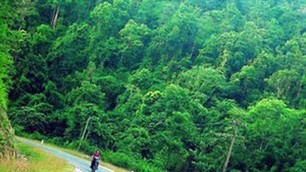Hello and welcome to the Sunday show, our biggest feature of the week on Voice of Vietnam Radio showcasing Vietnam’s traditional culture, hospitable people and beautiful landscapes.
Covered by more than 1.3 million hectares of natural forest and spreading over nine mountainous districts, the Western Nghe An Biosphere Reserve is the only remaining area in northern Vietnam boasting a large expanse of well-preserved primary forest. It is also the largest Biosphere Reserve in South East Asia. The reserve creates a green corridor through Pu Mat National Park – a storehouse of fauna and flora species, Pu Huong and Pu Hoat Nature Reserves. On this week’s Sunday Show, we will tell you about this reserve recognized by UNESCO for its ecological and cultural values.
 |
| Nghe An primitive forest |
The Western Nghe An Biosphere Reserve is home to more than 2,500 flora species, 130 mammals, 295 bird species, 54 amphibians and reptiles, 84 fish species, 39 bat species, and thousands of different insects. Thanks to its rich biodiversity, the Reserve has been recognized as a typical tropical forest with varied habitats including mountains, wetlands, and streams. Ho Duc Phoc is Deputy Secretary of Nghe An Province’s Party Committee: “We are honored that Pu Mat National Forest has been recognized as a world biosphere reserve. It is one of seven biosphere reserves in VN recognized by UNESCO for ecological and cultural values. With its diversity of plants and animals, the Reserve richly deserves this recognition”.
The Reserve is populated by ethnic minority groups of Thai, Mong, Tay Poong, and Kho Mu, with their unique traditional customs and festivals. The Reserve was recognized by UNESCO in 2007, but it wasn’t until April 2011, that the Nghe An People’s Committee officially announced UNESCO’s recognition. Nguyen Thanh Nhan, Director of the Pu Mat National Park explains the reason: “Why did we wait until now to declare the UNESCO recognition? First, we wanted to make the entire community aware of the fact that it requires a long process to gain this recognition. Second, the time is now ripe for the declaration. Since its recognition in 2007, any activities relating to the Western Nghe An Biosphere Reserve have received serious interest from the provincial People’s Committee and relevant agencies. We understand that the recognition brings an honor and a brand name, but what we must focus on now is how to sustain this brand”.
It’s really hard to be recognized as a world biosphere reserve, it’s even harder to conserve the achievement, and to ensure its sustainable growth. Tourism development is considered one effective way to give the provinces containing this reserve some economic benefits. The raising of community awareness and the active involvement of authorities at all levels are prerequisites for preserving and tapping the reserve efficiently. Pham Quoc Quan is Director of the Revolutionary Museum: “VN is facing a big problem in the preservation and upholding of the values of heritages and reserves in the community. If we don’t have a good protection plan, any investment in the reserve will be wasted”.
Professor Nguyen Hoang Tri is Secretary General of the National Committee of the Vietnamese Human and Biosphere Programme: “We should know that a biosphere reserve is a voluntary co-operative reserve created to protect the biological and cultural diversity of a region while promoting sustainable economic development. It is a place of co-operation, education and experimentation, where scientists and managers can share research data to better understand man’s impact on nature. We should balance these fundamental functions. We now have compiled materials to guide us in combining culture in the biosphere reserve. Regarding this work, I think the provincial Culture, Sports and Tourism Department should play a key role in linking the preservation of biosphere diversity and culture in the region”.
The UNESCO recognition is of significance as it offers the reserve and its region a so-called ‘brand-name’ in terms of biodiversity and the culture of the local ethnic groups. It’s also an acknowledgement of local efforts to protect forests and preserve the local culture, offering new opportunities for preservation activities in Nghe An Province. Professor Nguyen Hoang Tri again: “Through the recognition, VN has proven its initiative in preservation. That is to create a corridor among the three core zones of the Western Nghe An Biosphere Reserve. The corridor will help preserve rare birds, animals, insects and other species sustainably. The corridor will create a cultural space for the region that encourages local people to be involved more in conservation. In addition, it will offer a chance for climate change research”.
As a result of the recognition, there is likely to be more investment in biodiversity researches that could lead to new discoveries that increase the value of the Reserve. Nguyen Thanh Nhan, Director of the Pu Mat National Park again: “This reserve is important in terms of preservation, sustainable development and logistics. Particularly, any provinces which are located in or near the reserve will receive many investment projects for preserving biodiversity and local cultural identities”
You’ve been listening to the Sunday Show on the Voice of Vietnam. In this week’s edition, we introduced to you the Western Nghe An Biosphere Reserve which has been recognized by UNESCO for its ecological and cultural value. Next week, we’ll give you an in-depth look at the culture of ethnic people living in the region. That’s our show for today. Meet again next Sunday for another edition of the Sunday Show on the Voice of Vietnam.Thanks for your attention, Good-bye!